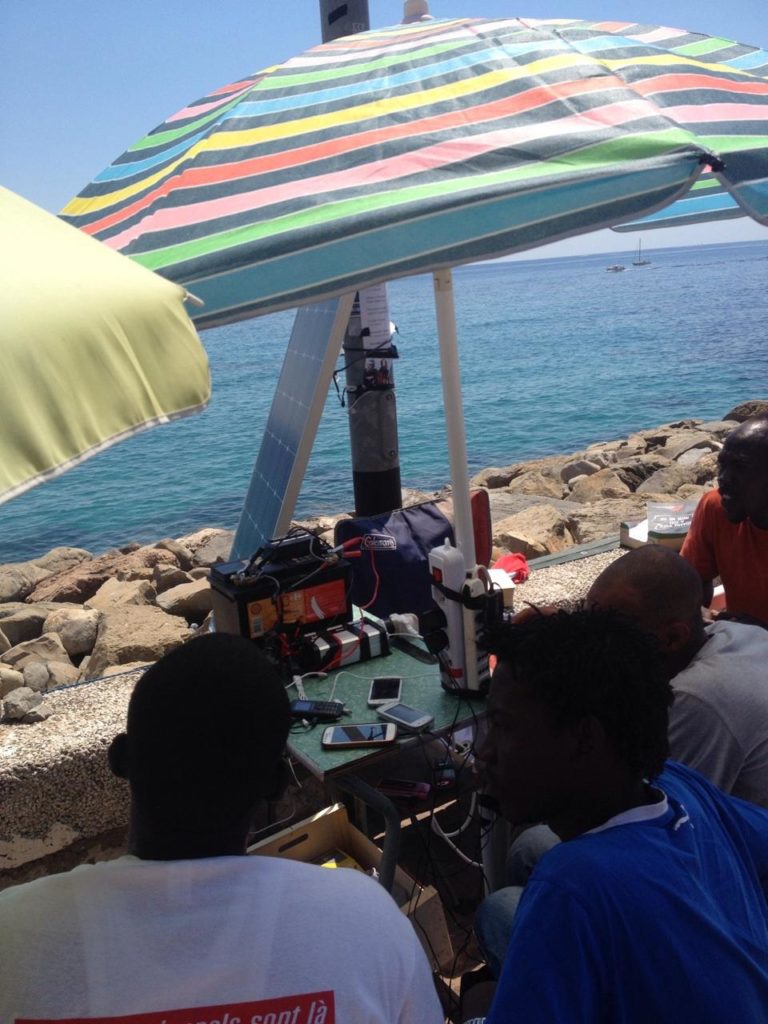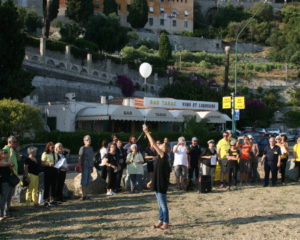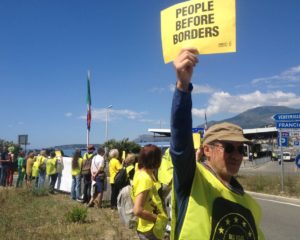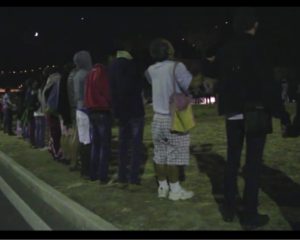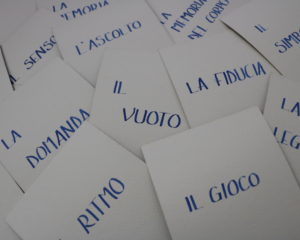There is a solar parasol which supplies the electricity for the iPhones as monitors and the hard disk, so that the visitors can follow the statements and two documentaries recorded in June 2015 in Ventimiglia, Italy, where refugees were blocked at the Italian-French border.
The background: For several weeks there were thousands of migrants blocked in whole Italy, due to the temporal suspension of the Schengen Agreement because of the G7 summit in the south of Germany. Hundreds arrived in Ventimiglia to find their way to the north of Europe, but France closed its border for them as well. So the blocked people spent several days and nights on the bare red rocks of Balzi Rossi at the Mediterranean shore: they wanted to protest against this – for them not understandable – French decision, especially because most of them only wanted to pass trough France on their way to other northern countries.
During this period the small Italian frontier town was somehow in state of emergency: on one hand were the refugees, lacking almost everything; on the other the citizens, trying to provide them with their most essential needs. The atmosphere of solidarity in these days was impressive. Besides water, food, clothing and blankets, there was a need of electricity. A citizen recognised this necessity and brought, in addition to a parasol against the burning sun, a solar panel. This gave the stranded people the possibility to recharge their cell phones. This is an important communication tool, to stay in contact with people at home or at their destination or to friends as well on the journey, somewhere in between home and a safe country. In fact, for the refugees, on the road during many weeks, the telephone contact is often the only social contact to close people or people who could give a trusted advice: essential if you are somewhere all alone and not knowing where to go.
The reports of the refugees inspired Lucia and Rebecca to record the narratives. They wanted to give these people a space for their voice in an artwork, to break up the fact that refugees are often only known by numbers. But there are stories of unbelievable voyages, where people are forced to go from A to C and D to reach B. Often they are blocked somewhere in between because of the sea, a wall at the European external borders and recently even at the European inner borders, said to be open, but not for them. These flights leave the people often disorientated, since they are finding themselves often on unknown ways, not knowing exactly where they are, neither where they will finally arrive: like in a labyrinth.
Due to this recognition Lucia and Rebecca decided to integrate a solar parasol (provided by Ombrellone solare) and the recordings and two documentaries made by local TV stations to Rebecca’s current exhibition “The truth of the labyrinth” at the Spazio Testoni, Bologna, Italy. From 30th September 31th October 2015 the installation can be seen there.
The irony of the events wanted, that just in the morning before the opening the Italian police dissolved the self organized protest camp of refugees in front of the Italian-French border. 30 migrants and 20 activists fled back to the red rocks of Balzi Rossi where they held out during the day. After hard negotiations they finally left the rocks in the afternoon to be transported into regular camps. With that ended for the time being the protest against the inhumane politics against the refugees. An hour later was the opening of the presentation of L5 minutes free zone3ucia’s and Rebecca’s installation, so it got to be as well a testimony.
“5 minutes free zone” motivated by the events of this summer in general and especially by the initiative of the solar panels, transforms documentary to an artwork with political claim.
The statements are three small films turned by Lucia: a Sudanese and an Eritrean are speaking about their flight from Africa and their actual situation in Ventimiglia. Pasquale from Dolceaqua explains how he constructed a solar panel. In the video “Notte di frontiera Ventimiglia – Internazione” the visitor can follow the meditation and celebrations on the occasion of the international refugees day the 21st June 2015. The reportage “Voci e racconti dal presidio NoBorders” documents the situation in Ventimiglia in June 2015, with a statement of a Sudanese refugee and recordings of a demonstration for human rights and free movement of persons for all human beings.
Un ombrellone solare che produce elettricità e alimenta due iPhones che fungono da schermi e un had disco, permettendo ai visitatori di vedere dei video con le testimonianze che ho registrato a giugno 2015 a Ventimiglia, dove molti rifugiati erano bloccati alla frontiera italo- francese.
“Premessa: Per svariate settimane migliaia di migranti sono rimasti bloccati in Italia, a causa della sospensione temporanea del Trattato di Shenghen per via del G7 nel sud della Germania. Centinaia sono arrivati a Ventimiglia per cercare di trovare una via di passaggio verso in nord Europa ma la Francia ha chiuso le frontiere anche per loro. Per questo, le persone bloccate hanno trascorso tre mesi occupando e vivendo sulla scogliera dei Balzi Rossi al confine: volevano protestare contro questa- per loro incomprensibile- decisione della Francia specialmente perché molti di loro volevano semplicemente attraversarla per raggiungere altri Paesi.
Durante questo periodo la piccola città di confine è stata in qualche modo in stato di emergenza: da una parte i rifugiati, che avevano bisogno di tutto; dall’altra parte i cittadini, che cercavano di provvedere ai loro bisogni primari. L’atmosfera di solidarietà in quei giorni, è stata impressionante. Oltre all’acqua, al cibo e alle coperte e ai vestiti, c’era bisogno di corrente elettrica. Un cittadino ha compreso questo bisogno e ha portato, oltre ad un ombrellone, un pannello fotovoltaico. Questo ha dato la possibilità ai profughi di ricaricare le batterie dei cellulari. Il telefono è un mezzo di comunicazione importante, per restare in contatto con persone e familiari a casa o alle loro destinazioni e far sapere che si è arrivati salvi in un luogo. Infatti per i rifugiati, in cammino da molto tempo, il telefono è spesso l’unico mezzo per contattare conoscenti e persone di fiducia, essenziale se si è in un luogo da soli e non si sa dove andare.” Astrid Gallinat, ArtificialisI racconti dei rifugiati mi hanno ispirata a registrarne la testimonianza. Volevo che queste persone potessero avere una voce che potesse essere ascoltata, potenzialmente un’opera per rompere col considerarli delle masse anonime o dei numeri. Ci sono storie di viaggi incredibili, dove persone sono costrette ad andare da A a C e D per raggiungere B. Spesso sono bloccati in un limbo intermedio a causa del mare, un muro ai confini esterni europei e recentemente anche bloccati ai confini europei interni, che sono normalmente aperti tranne che per loro. Ecco perché questi percorsi ricordano il viaggio all’interno di un labirinto.
I filmati sono due video ripresi da me a Ventimiglia: un uomo sudanese e un ragazzo eritreo parlano della loro fuga dalla’Africa e della loro situazione a Ventimiglia. Pasquale di Dolceacqua spiega come ha costruito l’ombrellone fotovoltaico, mentre nel video “notti di frontiera” del giornale “Internazionale”, i visitatori possono vedere come si è svolta la serata della giornata mondiale dei rifugiati 2015 in frontiera dove ho organizzato un momento di meditazione collettiva al quale sono seguiti i festeggiamenti.



